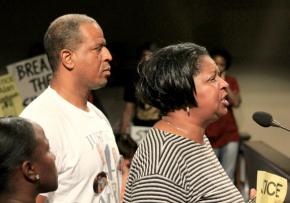So much for free speech
reports on how the Oakland City Council responded to questions about a police murder--by trying to shut down free speech.
A WEEK after family members and supporters of Alan Blueford organized a protest at Oakland City Hall to demand answers about the police killing of the African American teenager in May, city officials announced plans to prevent future demonstrations.
On September 18, the family of Alan Blueford and more than 100 supporters flooded City Council chambers. After they grilled the council members for 30 minutes, Council President Larry Reid announced that Police Chief Howard Jordan would deliver a police report on Blueford's killing to the family that night.
Forty-five minutes later, neither Chief Jordan nor the report arrived. When the council tried to resume city business without addressing the family's demands, the audience responded with an outburst of protest that effectively shut down the meeting.
To prevent demonstrations in the future, council members told the press that they would take measures to clamp down. Oakland City Administrator Deanna Santana proposed eliminating nearly half of the 214 seats in the council's City Hall chambers by prohibiting people from sitting in the upstairs galleries.
The plan would also bar people from standing in the chambers or congregating in the hallway outside. Both have been common practice for years, allowing scores of additional people to attend the council's meetings.
These changes are a flagrant maneuver to shut down free speech at a time when people are taking action to hold the Oakland Police Department and the city accountable. City officials, however, are justifying the changes by arguing that they will make City Council meetings safe--in particular, from protests by activists from Occupy Oakland.
The idea that Oakland City Council meetings are unsafe is fictitious. In an interview with the San Francisco Chronicle, Council President Reid claimed that the galleries overlooking the chambers have to be closed because of the threat of physical violence. "It's a potential danger to the staff and council members below the balcony," Reid said. "It makes no sense to be sitting there trying to do your job, and you're worried that somebody up in the balcony may throw something down at you."
Yet Reid was unable to remember any instance in which objects were thrown from the balcony--and no one else can provide an account of violence at a City Council meeting. Furthermore, at least half a dozen armed officers are on duty inside the chambers during meetings.
The allegation that the council has to protect itself specifically against Occupy Oakland is the latest in an ongoing scapegoating campaign from Mayor Jean Quan and other city officials. From gang shootings to a decline in business revenue to poverty, the city establishment seems willing to blame Occupy activists for problems that date back for decades.
Right now, one in six children in Oakland lives in extreme poverty, 30 percent of homes in West Oakland are in foreclosure, five schools are due to be closed, and the Oakland police are so corrupt and abusive that the department may be taken over by the Feds. Occupy Oakland didn't cause these problems. Austerity and racism are at their roots.
THE MAIN reason the Oakland City Council is trying to shut down protests at their meetings now is to stop the Justice for Alan Blueford movement.
In May 2012, Alan Blueford was shot and killed by Oakland Police Officer Miguel Masso. Initial reports from the Oakland Police Department (OPD) accused Alan of initiating a gun battle that led to his death. But in the weeks and months following his death, details emerged showing that Alan had no gun residue on his hands, had no drugs or alcohol in his system, and was likely shot while on the ground, since bullets entered his body at an upward angle.
Recently, police "leaked" the claim that a gun found 20 feet away from Alan's body had his fingerprints on it. But the department refuses to share this report, and questions have been raised about why it took five months for cops to make this "discovery" public.
The bravery and tenacity of the Blueford family in attempting to find the truth about their son's death is something that Oakland city officials now have to reckon with. To strengthen their fight, a group of activists has formed the Justice for Alan Blueford (JAB) Coalition to work directly with the family to raise awareness and support.
Fighting together, they have countered repeated attempts to slander Alan's character by city officials or the local media. The Blueford's push for justice has put the OPD and city officials in a vulnerable position.
If campaigns against police violence continue to grow, it could undermine the City Council's plans to enact austerity and keep poor communities in line. Families who fight back can rally support and build the confidence of other victims or their families to take a stand. This could lead to a mass movement that would force the OPD and the City Council to answer to the community.
That is the real threat facing Oakland City Hall--and that's why city officials are trying to squelch free speech.
To continue the campaign to get justice for Alan Blueford, his family, the JAB coalition, and members of the clergy plan to march on City Hall on October 2 at 5 p.m. Everyone who wants to see justice on the streets of Oakland and fight back against the New Jim Crow should join them.



